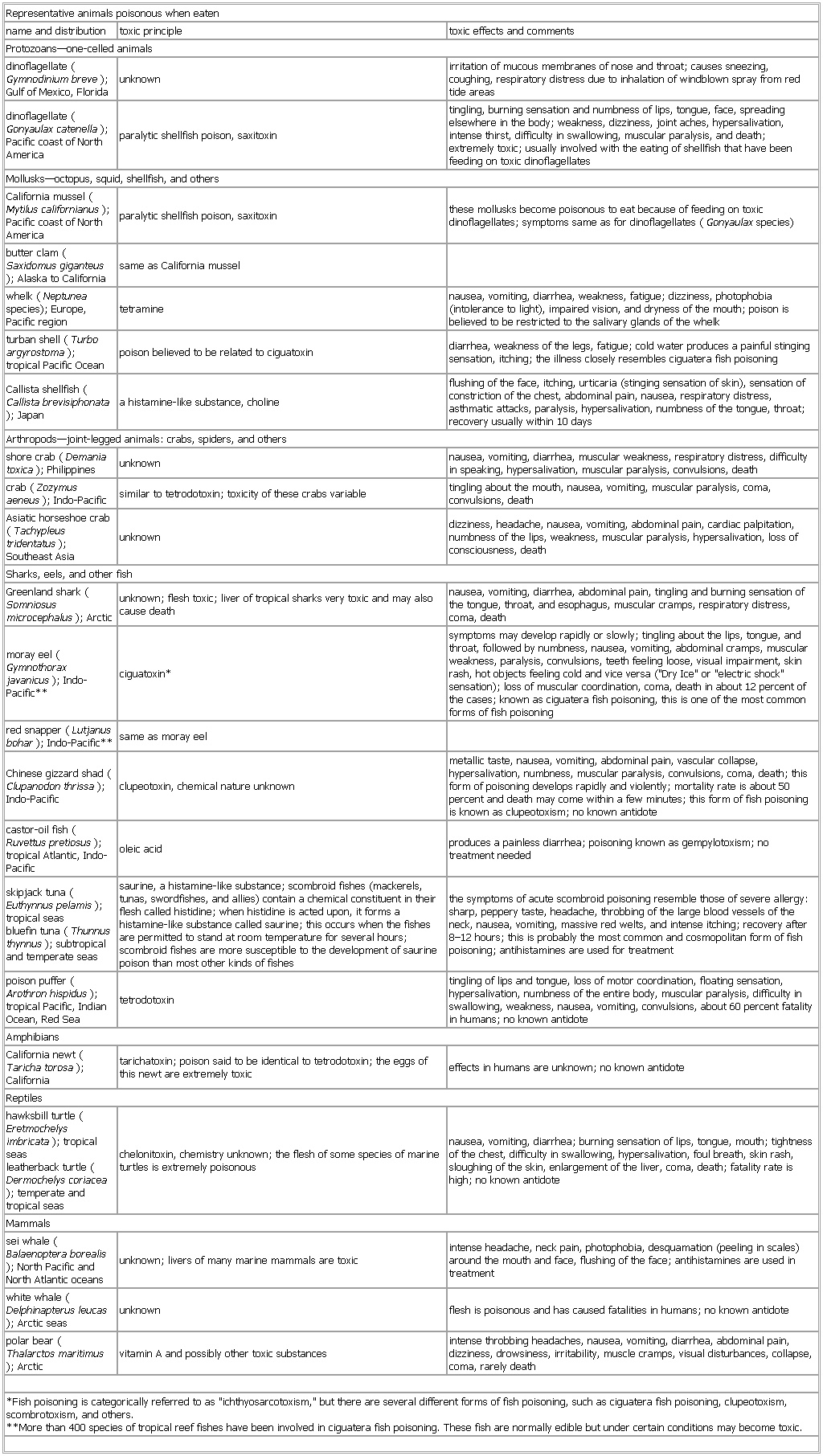- Representative animals poisonous when eaten
-
▪ TableRepresentative animals poisonous when eatenname and distribution toxic principle toxic effects and commentsProtozoans—one-celled animalsdinoflagellate (Gymnodinium breve); Gulf of Mexico, Florida unknown irritation of mucous membranes of nose and throat; causes sneezing, coughing, respiratory distress due to inhalation of windblown spray from red tide areasdinoflagellate (Gonyaulax catenella); Pacific coast of North America paralytic shellfish poison, saxitoxin tingling, burning sensation and numbness of lips, tongue, face, spreading elsewhere in the body; weakness, dizziness, joint aches, hypersalivation, intense thirst, difficulty in swallowing, muscular paralysis, and death; extremely toxic; usually involved with the eating of shellfish that have been feeding on toxic dinoflagellatesMollusks—octopus, squid, shellfish, and othersCalifornia mussel (Mytilus californianus); Pacific coast of North America paralytic shellfish poison, saxitoxin these mollusks become poisonous to eat because of feeding on toxic dinoflagellates; symptoms same as for dinoflagellates (Gonyaulax species)butter clam (Saxidomus giganteus); Alaska to California same as California musselwhelk (Neptunea species); Europe, Pacific region tetramine nausea, vomiting, diarrhea, weakness, fatigue; dizziness, photophobia (intolerance to light), impaired vision, and dryness of the mouth; poison is believed to be restricted to the salivary glands of the whelkturban shell (Turbo argyrostoma); tropical Pacific Ocean poison believed to be related to ciguatoxin diarrhea, weakness of the legs, fatigue; cold water produces a painful stinging sensation, itching; the illness closely resembles ciguatera fish poisoningCallista shellfish (Callista brevisiphonata); Japan a histamine-like substance, choline flushing of the face, itching, urticaria (stinging sensation of skin), sensation of constriction of the chest, abdominal pain, nausea, respiratory distress, asthmatic attacks, paralysis, hypersalivation, numbness of the tongue, throat; recovery usually within 10 daysArthropods—joint-legged animals: crabs, spiders, and othersshore crab (Demania toxica); Philippines unknown nausea, vomiting, diarrhea, muscular weakness, respiratory distress, difficulty in speaking, hypersalivation, muscular paralysis, convulsions, deathcrab (Zozymus aeneus); Indo-Pacific similar to tetrodotoxin; toxicity of these crabs variable tingling about the mouth, nausea, vomiting, muscular paralysis, coma, convulsions, deathAsiatic horseshoe crab (Tachypleus tridentatus); Southeast Asia unknown dizziness, headache, nausea, vomiting, abdominal pain, cardiac palpitation, numbness of the lips, weakness, muscular paralysis, hypersalivation, loss of consciousness, deathSharks, eels, and other fishGreenland shark (Somniosus microcephalus); Arctic unknown; flesh toxic; liver of tropical sharks very toxic and may also cause death nausea, vomiting, diarrhea, abdominal pain, tingling and burning sensation of the tongue, throat, and esophagus, muscular cramps, respiratory distress, coma, deathmoray eel (Gymnothorax javanicus); Indo-Pacific** ciguatoxin* symptoms may develop rapidly or slowly; tingling about the lips, tongue, and throat, followed by numbness, nausea, vomiting, abdominal cramps, muscular weakness, paralysis, convulsions, teeth feeling loose, visual impairment, skin rash, hot objects feeling cold and vice versa ("Dry Ice" or "electric shock" sensation); loss of muscular coordination, coma, death in about 12 percent of the cases; known as ciguatera fish poisoning, this is one of the most common forms of fish poisoningred snapper (Lutjanus bohar); Indo-Pacific** same as moray eelChinese gizzard shad (Clupanodon thrissa); Indo-Pacific clupeotoxin, chemical nature unknown metallic taste, nausea, vomiting, abdominal pain, vascular collapse, hypersalivation, numbness, muscular paralysis, convulsions, coma, death; this form of poisoning develops rapidly and violently; mortality rate is about 50 percent and death may come within a few minutes; this form of fish poisoning is known as clupeotoxism; no known antidotecastor-oil fish (Ruvettus pretiosus); tropical Atlantic, Indo-Pacific oleic acid produces a painless diarrhea; poisoning known as gempylotoxism; no treatment neededskipjack tuna (Euthynnus pelamis); tropical seasbluefin tuna (Thunnus thynnus); subtropical and temperate seas saurine, a histamine-like substance; scombroid fishes (mackerels, tunas, swordfishes, and allies) contain a chemical constituent in their flesh called histidine; when histidine is acted upon, it forms a histamine-like substance called saurine; this occurs when the fishes are permitted to stand at room temperature for several hours; scombroid fishes are more susceptible to the development of saurine poison than most other kinds of fishes the symptoms of acute scombroid poisoning resemble those of severe allergy: sharp, peppery taste, headache, throbbing of the large blood vessels of the neck, nausea, vomiting, massive red welts, and intense itching; recovery after 8–12 hours; this is probably the most common and cosmopolitan form of fish poisoning; antihistamines are used for treatmentpoison puffer (Arothron hispidus); tropical Pacific, Indian Ocean, Red Sea tetrodotoxin tingling of lips and tongue, loss of motor coordination, floating sensation, hypersalivation, numbness of the entire body, muscular paralysis, difficulty in swallowing, weakness, nausea, vomiting, convulsions, about 60 percent fatality in humans; no known antidoteAmphibiansCalifornia newt (Taricha torosa); California tarichatoxin; poison said to be identical to tetrodotoxin; the eggs of this newt are extremely toxic effects in humans are unknown; no known antidoteReptileshawksbill turtle (Eretmochelys imbricata); tropical seasleatherback turtle (Dermochelys coriacea); temperate and tropical seas chelonitoxin, chemistry unknown; the flesh of some species of marine turtles is extremely poisonous nausea, vomiting, diarrhea; burning sensation of lips, tongue, mouth; tightness of the chest, difficulty in swallowing, hypersalivation, foul breath, skin rash, sloughing of the skin, enlargement of the liver, coma, death; fatality rate is high; no known antidoteMammalssei whale (Balaenoptera borealis); North Pacific and North Atlantic oceans unknown; livers of many marine mammals are toxic intense headache, neck pain, photophobia, desquamation (peeling in scales) around the mouth and face, flushing of the face; antihistamines are used in treatmentwhite whale (Delphinapterus leucas); Arctic seas unknown flesh is poisonous and has caused fatalities in humans; no known antidotepolar bear (Thalarctos maritimus); Arctic vitamin A and possibly other toxic substances intense throbbing headaches, nausea, vomiting, diarrhea, abdominal pain, dizziness, drowsiness, irritability, muscle cramps, visual disturbances, collapse, coma, rarely death*Fish poisoning is categorically referred to as "ichthyosarcotoxism," but there are several different forms of fish poisoning, such as ciguatera fish poisoning, clupeotoxism, scombrotoxism, and others.**More than 400 species of tropical reef fishes have been involved in ciguatera fish poisoning. These fish are normally edible but under certain conditions may become toxic.See as table:

* * *
Universalium. 2010.
